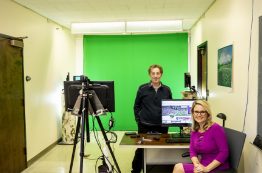Consider this: the U.S. West Coast has seen a decrease in rainfall between 1981-2018. UW scientists think a phenomenon called the Madden-Julian Oscillation (MJO) might be to blame. A stormy disturbance that occurs several times a year in the tropics, the MJO is similar to the El Nino Southern Oscillation, which is notorious for generating extreme winter weather in the Pacific Northwest.
Read more at Nature »Two UW Environment scientists awarded Sloan Fellowships for early-career research
Two faculty members at the University of Washington have been awarded early-career fellowships from the Alfred P. Sloan Foundation. The new Sloan Fellows, announced Feb. 12, are Kyle Armour and Jacqueline Padilla-Gamiño, both assistant professors in the College of the Environment. Open to scholars in eight scientific and technical fields — chemistry, computer science, economics, mathematics, molecular biology, neuroscience, ocean sciences and physics — the fellowships honor those early-career researchers whose achievements mark them among the next generation of scientific leaders.
Read more at UW News »Polar bears in Baffin Bay skinnier, having fewer cubs due to less sea ice
Polar bears are spending more time on land than they did in the 1990s, due to reduced sea ice, new University of Washington-led research has found. Bears in Baffin Bay are getting thinner and adult females are having fewer cubs than was recorded at times when sea ice was more available. The new study published in Ecological Applications compares polar bear satellite tracking and visual monitoring data from the 1990s with more data collected in recent years.
Read more at UW News »Luke Tornabene: Curator and Ichthyology Professor
In 2017, University of Washington ichthyologist Luke Tornabene was inside a small submersible called Idabell near the island of Roatan, Honduras. Sitting next to him were a masters’ student in his lab named Rachel Manning, and a pilot. They were collecting samples of marine life 550 feet deep when they spotted an unfamiliar bright blue and yellow fish. “We knew it was something new before we even got it into the collection tube,” Tornabene says, excitement still clear in his voice.
Read more »UW’s new broadcast meteorology course is first on West Coast
The University of Washington has long boasted one of the country’s top programs in atmospheric sciences. Now, the UW is also teaching undergraduates how to share that knowledge online and on TV as a broadcast meteorologist. The Media & Meteorology class, launched in winter quarter, is open to students from across the university who are taking or have passed a prerequisite introductory courses in atmospheric sciences.
Read more at UW News »





